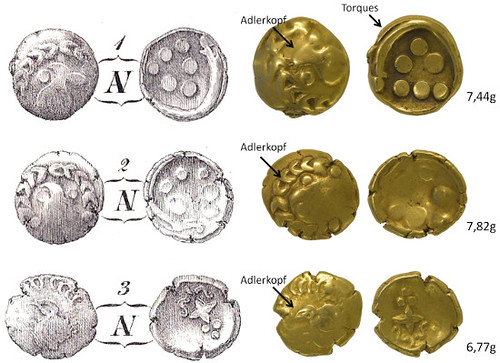
PREV ARTICLE
NEXT ARTICLE
FULL ISSUE
PREV FULL ISSUE
BAVARIAN RAINBOW CUPS: RARE CELTIC GOLD STATERSPennies from Heaven? How about Bavarian rainbow
cups? An article in the April 10, 2014 CoinsWeekly
discusses three long-lost gold staters with an intriguing history
and creation myth. Here's an excerpt. Be sure to read the
complete article online. -Editor
In the Alpine valley Etschtal, two major Celtic currency zones collided: Northern Italian restrikes of the silver drachms from Massilia (today: Marseille) and the so called Bavarian rainbow cups, ca. 7.5 g heavy gold staters. According to popular belief, rainbows left a piece of gold - the rainbow cups - behind where they had touched the ground. Gold coins like this very often surfaced on fields after heavy rainfalls. Similar circumstances also led to the discovery of three Celtic rainbow cups in Castello, near Brentonico (Rovereto), back in the year 1827. The coins were acquired by Giovanni Battista Noriller (1789-1872), an attorney, who described and illustrated them in his book "I Lavini di Marco" (Rovereto, 1871). In 1923, the Noriller collection and the Brentonico coins ended up in the collection of famous archaeologist Paolo Orsi and were then exhibited in the Museum in Rovereto. The museum sold the coins in the 1920s in order to pay for the heating costs of the museum’s office rooms. 15 years ago, two of the Brentonico rainbow cups suddenly appeared on the Veronese coin market. Unlike other Celtic gold coins, whose origin can with certainty be traced to Greek coins, the imagery on the rainbow cups from Southern Germany established a completely autonomous symbolic language. That is why scholars in the 17th century believed the coins had literally fallen from the sky or sprung from the earth. This unfamiliar, abstract and often purely ornamental imagery was often considered primitive and barbaric up until the 19th century. Today, in a time where we are used to the style of artists like Klee, Picasso or Mirò, we can appreciate the imaginative design of some Celtic coins. 
Comparison of Norill's drawings and the rediscovered originals. All three gold coins from Brentonico, which with regard to their weight (6.77 g to 7.82 g) nominally correspond roughly to Greek staters, depict a convex bird head with a curved beak. Two of them further show a torc and six balls inside it on the concave side. These coins also feature a ball above and below the beak. The balls possibly indicate the coin’s value in analogy to the Republican Roman As, a bronze coin with a ship bow. The depicted torc is a metal ring which was worn by Celtic, or more precisely by Gaulish, warriors as necklace and status symbol. To read the complete article, see: Rediscovery of Celtic gold in Brentonico (www.coinsweekly.com/en/Rediscovery-of-Celtic-gold-in-Brentonico/8?&id=389&type=a)  Wayne Homren, Editor The Numismatic Bibliomania Society is a non-profit organization promoting numismatic literature. See our web site at coinbooks.org. To submit items for publication in The E-Sylum, write to the Editor at this address: whomren@gmail.com To subscribe go to: https://my.binhost.com/lists/listinfo/esylum All Rights Reserved. NBS Home Page Contact the NBS webmaster 
|